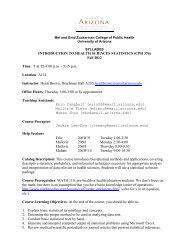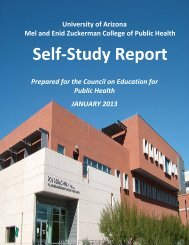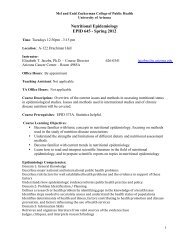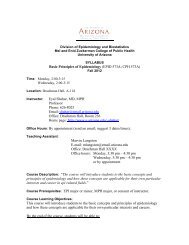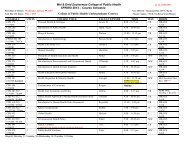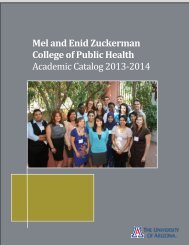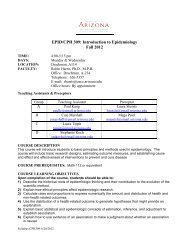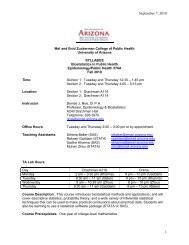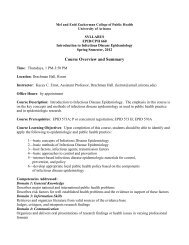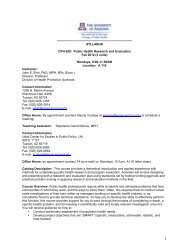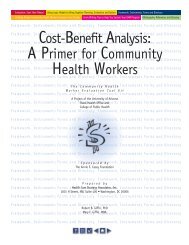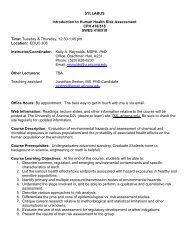EPID 573C Advanced Epidemiology - Mel and Enid Zuckerman ...
EPID 573C Advanced Epidemiology - Mel and Enid Zuckerman ...
EPID 573C Advanced Epidemiology - Mel and Enid Zuckerman ...
Create successful ePaper yourself
Turn your PDF publications into a flip-book with our unique Google optimized e-Paper software.
<strong>Mel</strong> <strong>and</strong> <strong>Enid</strong> <strong>Zuckerman</strong> College of Public HealthUniversity of ArizonaSYLLABUS<strong>Advanced</strong> <strong>Epidemiology</strong><strong>EPID</strong>/CPH <strong>573C</strong>Fall Semester 2012Time:Monday 2:00 – 4:50 p.m.Location: Drachman Hall A-112Instructors:Office Hours:Teaching Assistant:TA Office Hours:Zhao Chen, PhD, MPHProfessor of Public Health1295 N. MartinDrachman Hall, A238Tucson, AZ 85724Telephone: 626-9011zchen@email.arizona.eduBy AppointmentNoneN/ACatalog Description:An advanced course in quantitative issues that arise in the planning, analysis, <strong>and</strong> interpretation ofepidemiologic research studies. Students must also know how to use a statistical software package (e.g.STATA).Course Description:Through homework <strong>and</strong> class projects, students will gain h<strong>and</strong>s-on experience of epidemiologicresearch.Course Prerequisites:Statistics:<strong>Epidemiology</strong>:<strong>Epidemiology</strong> 576A (Biostatistics for Public Health)<strong>Epidemiology</strong> 576B (Biostatistics for Research)<strong>Epidemiology</strong> 573A (Basic Principles in <strong>Epidemiology</strong>)<strong>Epidemiology</strong> 573B (Epidemiologic Methods)Computing:Ability to use statistical computing packages (e.g. Stata, SAS, S-plus, or SPSS)
2Course Learning Objectives: At the end of the course students should be able to better:1. Interpret disease frequency, association, <strong>and</strong> effect as commonly considered in epidemiologicstudies;2. Critically evaluate the validity of proposed <strong>and</strong> completed studies, addressing potential sourcesof bias:(a) selection (response) bias,(b) information bias,(c) confounding;3. Underst<strong>and</strong> the advantages of stratification, matching, <strong>and</strong> statistical adjustment for control ofconfounding;4. Underst<strong>and</strong> the value of the r<strong>and</strong>omized clinical trial as an epidemiologic resource;5. Underst<strong>and</strong> the application of the graphical representation of causality in epidemiology;6. Identify research questions <strong>and</strong> form research hypotheses;7. Plan <strong>and</strong> perform statistical analyses in epidemiologic research; <strong>and</strong>8. Communicate epidemiologic research findings in both oral <strong>and</strong> written formats.MPH/SECTION Competencies Covered:The class will cover all the MPH competencies under analytical, communication, cultural <strong>and</strong> basicpublic health science skills. http://www.publichealth.arizona.edu/academics/mphRequired Textbook:Moyses Szklo & F. Javier Nieto. <strong>Epidemiology</strong>---Beyond the Basics (2 nd edition). An Aspen Publication2007.Recommended Textbook:Kenneth J. Rothman, S<strong>and</strong>er Greenl<strong>and</strong> & Timothy L. Lash. Modern <strong>Epidemiology</strong> (3 nd edition).Lippincott-Raven 2008 (AHSL reserve).Course Requirements:Students are required to actively participate in class discussion <strong>and</strong> to collaboratively work in a group duringthe semester. Class assignments, including reading assignments, must be completed before each lecture.Assignmentsa. Reading: Book chapters <strong>and</strong> papers are listed corresponding to each lecture in thecourse schedule. Students are expected to read each of the assigned book chapters
efore the lecture <strong>and</strong> be ready to discuss them in class. The papers are recommendedreadings <strong>and</strong> supplementary to the book chapter.b. Homework: There are three computer-based homework assignments throughout thesemester. You are expected to complete all these homework assignments <strong>and</strong> discussthe results in class. In addition, you will be given papers to read <strong>and</strong> prepare for classdiscussions.c. Midterm: midterm will be a take-home exam. You will be asked to read anepidemiologic research paper <strong>and</strong> answer questions related to the paper.d. Course project:• Throughout of the semester, you will be working with a group of students on anepidemiologic dataset to test a hypothesis that you have formed.• You will write <strong>and</strong> submit an abstract to report your findings at an in-class scientificconference. Per the conference assignment, you will give either an oral or a posterpresentation. The abstract <strong>and</strong> presentation will be individual work based on the analysesdone by the group.• A completed manuscript based on your findings in the research project will be due by the endof the semester. The paper will be a group work.e. Final exam --- critique presentation: You are responsible for presenting a critiquereview of a significant epidemiology paper (20 minutes). You are encouraged toselect one paper from the list provided. You must let Dr. Chen know as soon aspossible so she will reserve the paper for you. One student one paper <strong>and</strong> first comefirst serve. However, you may pick up your own paper if you are not interested in anyof these papers in the list. In that case, you must show the paper to Dr. Chen forapproval before you start your critique review.3Course Format: This class will be a combination of lectures <strong>and</strong> student presentations.Student Evaluation:5% Class participation (individual work)15% Homework (individual work)25% Midterm exam (individual work)10% Research abstract <strong>and</strong> presentation (individual work)20% Final exam ---critique presentation (individual work)25% Manuscript (group work)Class Attendance/Participation: Required. Prior permission from the course director should be received forany absence unless in emergence situations. Students who miss class without an instructor’s permission orwho have 2 or more absences during the semester may receive a deduction of the final grade. All holidays orspecial events observed by organized religions will be honored for those students who show affiliation with thatparticular religion. Absences pre-approved by the UA Dean of Students (or Dean’s designee) will be honored.
4Course Schedule# Date Topic Reading Assignment Due1 August 20 • Introduction R 1 , C 1 ClassDisease incide• Literature review <strong>and</strong> hypothesesproject• Class project overview2 August 27 • Disease incidence <strong>and</strong> risk• Measuring associations withconsideration of validity <strong>and</strong> biasR 2, C 2-4 H 1September 33 September10• Labor Day, no class• Noncausal associations:R 3 , C 5 H 1,confoundingLiterature• Project hypotheses <strong>and</strong> literaturereview <strong>and</strong>review resultshypotheses• Discuss H 14 September17• Effect modifications <strong>and</strong>interactions• Statistical modeling inepidemiologyR 4 , C 6-7 H 25 September24• Discuss the analysis plan for themanuscript• Discuss H2AnalysisplanH 26 October 1 • Measurement errors• Data managementC 8dataset forthe classproject, H 37 October 8 • Causal diagrams• Conceptual framework• H 38 October 15 • Use genetic approaches inepidemiologic studies (GuestLecture)R 5 H 3MidtermExam9 October 22 • Reporting epidemiologic research R 6 , C 9 MidtermExam10 October 29 • Review abstracts• Epidemiologic inferences <strong>and</strong>public health implicationsR 7 , C 10poster orslidesAbstract
5# Date Topic Reading Assignment Due11 November 5 • Class project presentation—Oralor PosterNovember 12 . Veterans Day (no class)12 November 19 • Review the draft of themanuscript• Multicenter studies13 November 26 • Grant application• Student final presentations14 December 3 • Student final presentationsR 8R 9Poster ororalpresentationDraft of themanuscript15 December 10 • Student final presentations FinalmanuscriptR 1-9 = Readings on D2LC 1-10 = Chapters in the required textbookH 1-3 = Homework on D2LCommunications: You are responsible for reading emails sent to your UA account from yourprofessor <strong>and</strong> the announcements that are placed on the course web site. Information about readings,news events, your grades, assignments <strong>and</strong> other course related topics will be communicated to youwith these electronic methods. The official policy can be found at:http://www.registrar.arizona.edu/emailpolicy.htmDisability Accommodation: If you anticipate issues related to the format or requirements of thiscourse, please meet with me. I would like us to discuss ways to ensure your full participation inthe course. If you determine that formal, disability-related accommodations are necessary, it isvery important that you be registered with Disability Resources (621-3268; drc.arizona.edu) <strong>and</strong>notify me of your eligibility for reasonable accommodations. We can then plan how best tocoordinate your accommodations. The official policy can be found at:http://catalog.arizona.edu/2012%2D13/policies/disability.htmAcademic Integrity: All UA students are responsible for upholding the University of Arizona Code ofAcademic Integrity, available through the office of the Dean of Students <strong>and</strong> online: The official policyfound at: http://deanofstudents.arizona.edu/codeofacademicintegrityClassroom Behavior: (Statement of expected behavior <strong>and</strong> respectful exchange of ideas)The Dean of Students has set up expected st<strong>and</strong>ards for student behaviors <strong>and</strong> has defined <strong>and</strong>identified what is disruptive <strong>and</strong> threatening behavior. This information is available at:http://deanofstudents.arizona.edu/disruptive<strong>and</strong>threateningstudentguidelinesStudents are expected to be familiar with the UA Policy on Disruptive <strong>and</strong> Threatening StudentBehavior in an Instructional Setting found at: http://policy.arizona.edu/disruptive-behavior-
instructional <strong>and</strong> the Policy on Threatening Behavior by Students found at:http://deanofstudents.arizona.edu/sites/deanofstudents.arizona.edu/files/Disruptive_threat_bklt_2012.pdfGrievance Policy: Should a student feel he or she has been treated unfairly, there are a number ofresources available. With few exceptions, students should first attempt to resolve difficulties informallyby bringing those concerns directly to the person responsible for the action, or with the student'sgraduate advisor, Assistant Dean for Student <strong>and</strong> Alumni Affairs, department head, or the immediatesupervisor of the person responsible for the action. If the problem cannot be resolved informally, thestudent may file a formal grievance using the Graduate College Grievance Policy found at:http://grad.arizona.edu/academics/policies/academic-policies/grievance-policyGrade Appeal Policy: http://catalog.arizona.edu/2012-13/policies/gradappeal.htmSyllabus Changes: Information contained in the course syllabus, other than the grade <strong>and</strong> absencepolicies, may be subject to change with reasonable advance notice, as deemed appropriate.6
7Communications: You are responsible for reading emails sent to your UA account from yourprofessor <strong>and</strong> the announcements that are placed on the course web site. Information aboutreadings, news events, your grades, assignments <strong>and</strong> other course related topics will becommunicated to you with these electronic methods. The official policy can be found at:http://www.registrar.arizona.edu/emailpolicy.htm.Disability Accommodation: If you anticipate issues related to the format or requirements ofthis course, please meet with me. I would like us to discuss ways to ensure your fullparticipation in the course. If you determine that formal, disability-related accommodations arenecessary, it is very important that you be registered with Disability Resources (621-3268;drc.arizona.edu) <strong>and</strong> notify me of your eligibility for reasonable accommodations. We can thenplan how best to coordinate your accommodations. The official policy can be found at:http://catalog.arizona.edu/2008%2D09/policies/disability.htm.Academic Integrity: All UA students are responsible for upholding the University of ArizonaCode of Academic Integrity, available through the office of the Dean of Students <strong>and</strong> online:The official policy found at: http://deanofstudents.arizona.edu/codeofacademicintegrity/.Classroom Behavior: (Statement of expected behavior <strong>and</strong> respectful exchange of ideas)The Dean of Students has set up expected st<strong>and</strong>ards for student behaviors <strong>and</strong> has defined<strong>and</strong> identified what is disruptive <strong>and</strong> threatening behavior.Students are expected to be familiar with the UA Policy on Disruptive Behavior in anInstructional Setting found at http://policy.arizona.edu/disruptive-behavior-instructional,<strong>and</strong> the Policy on Threatening Behavior by Students found athttp://policy.arizona.edu/threatening-behavior-students.Grievance Policy: Should a student feel he or she has been treated unfairly, there are a number ofresources available. With few exceptions, students should first attempt to resolve difficulties informallyby bringing those concerns directly to the person responsible for the action, or with the student'sgraduate advisor, Assistant Dean for Student <strong>and</strong> Alumni Affairs, department head, or the immediatesupervisor of the person responsible for the action. If the problem cannot be resolved informally, thestudent may file a formal grievance using the Graduate College Grievance Policy found athttp://grad.arizona.edu/academics/policies/academic-policies/grievance-policy.Grade Appeal Policy: http://catalog.arizona.edu/2012-13/policies/gradappeal.htm.Syllabus Changes: Information contained in the course syllabus, other than the grade <strong>and</strong>absence policies, may be subject to change with reasonable advance notice, as deemedappropriate.



